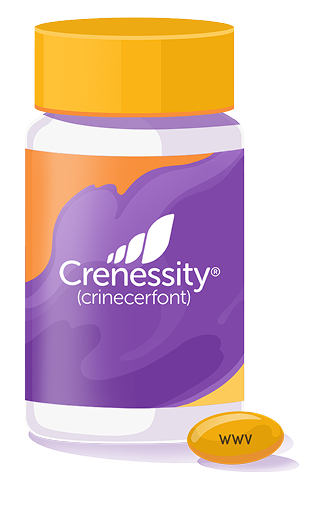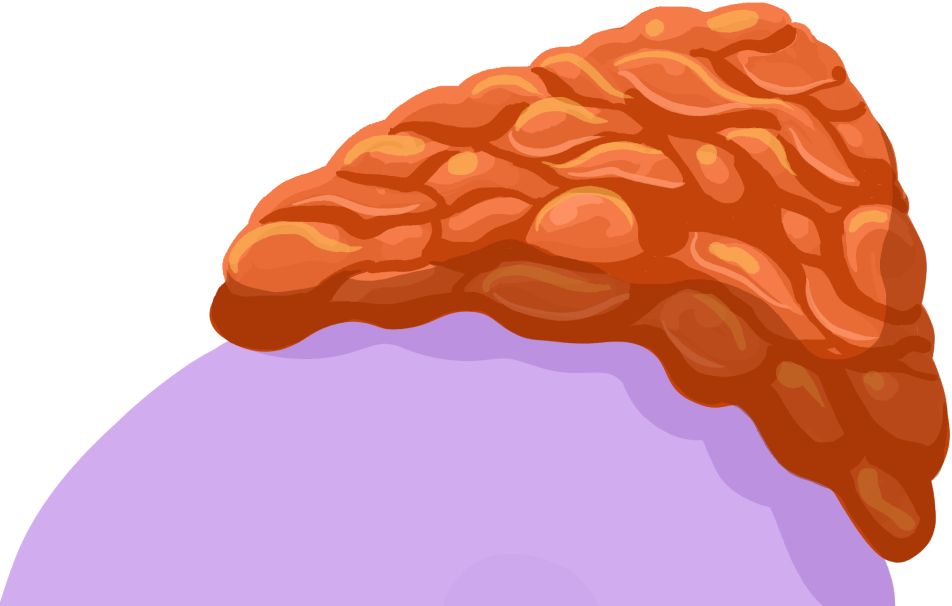CRENESSITY dosing varies by age and weight1
| Age and body weight | Recommended dosage |
|---|---|
| Adults (18 and older) and children weighing ≥55 kg | Capsules: 100 mg twice daily (200 mg per day) |
| Children weighing 20 to <55 kg | Capsules or oral solution: 50 mg twice daily (100 mg per day) |
| Children weighing 10 to <20 kg | Oral solution: 25 mg twice daily (50 mg per day) |

CRENESSITY is a CYP3A4 substrate¹
- CRENESSITY dose should be when coadministered with a strong or moderate CYP3A4 inducer1
- Please refer to the full Prescribing Information for full dosing information and additional considerations for patients taking CYP3A4 inducers or inhibitors
CRENESSITY does not address cortisol deficiency. Patients prescribed CRENESSITY should continue taking GCs.1
CRENESSITY should be used alongside GC therapy and has no contraindications with any specific GC used in the treatment of CAH.
Around-the-clock ACTH and androgen reduction
When comparing doses, twice-daily dosing led to the greatest reduction of androstenedione.3*
*A phase 2 study compared 50 mg once daily, 100 mg once daily, and 100 mg twice daily. Main outcomes included change from baseline to day 14 in ACTH, 17-OHP, androstenedione, and testosterone. 100 mg twice daily led to the greatest reductions.3
A pharmacokinetic profile that
supports twice-daily dosing1
Following oral administration, the time to reach maximum CRENESSITY plasma concentration is
4 hours1
The effective half-life of
CRENESSITY is approximately
14 hours1
CRENESSITY administration

of pediatric patients rated the oral solution as easy or very easy to take (n=35).5
Patients aged 6-17 years rated ease of administration on a 5-option scale ranging from very difficult to very easy.5
Support your patients taking CRENESSITY through GC down‑titration
Tailor the process to each patient’s clinical picture6
When reducing GCs, preparation and communication are key. Patients may experience withdrawal symptoms—especially with faster reductions—but these symptoms typically improve within a few weeks to a month. Setting expectations early can help maintain adherence to both CRENESSITY and the broader treatment plan. Discuss common symptoms of GC withdrawal.5
Patients prescribed CRENESSITY should continue taking GCs.1
GC Down-Titration
Explore GC reduction strategies, key clinical considerations, and the importance of ongoing patient monitoring.
Consider mineralocorticoid support during GC down-titration
Some GCs—especially hydrocortisone—have mineralocorticoid effects. As GC doses are lowered, mineralocorticoid activity may also decrease. This can increase the need for fludrocortisone supplementation.7
To guide mineralocorticoid adjustments, monitor8,9:
- Plasma renin levels
- Blood pressure
- Electrolyte levels
Every patient’s experience is different. Encourage ongoing dialogue as you adjust GC dosing alongside CRENESSITY treatment.6
ACCESS SIMPLIFIED
Dedicated team of Care Coordinators
The Neurocrine Access Support program provides patients a dedicated Care Coordinator as a central point of contact from initiation through their entire treatment journey.
Discover Access Support
Actor portrayals.
REFERENCES
- Crenessity. Package insert. Neurocrine Biosciences, Inc.
- Auchus RJ, Hamidi O, Pivonello R, et al. Phase 3 trial of crinecerfont in adult congenital adrenal hyperplasia. N Engl J Med. 2024;391(6):504-514. doi:10.1056/NEJMoa2404656
- Auchus RJ, Sarafoglou K, Fechner PY, et al. Crinecerfont lowers elevated hormone markers in adults with 21-hydroxylase deficiency congenital adrenal hyperplasia. J Clin Endocrinol Metab. 2022;107(3):801-812. doi:10.1210/clinem/dgab749
- Auchus RJ, Sarafoglou K, Geffner ME et al. Evaluation of potential drug-drug interactions with crinecerfont. Poster presented at: Endocrine Society Annual Meeting; July 12-15, 2025; San Francisco, CA.
- Data on file. Neurocrine Biosciences, Inc.
- Beuschlein F, Else T, Bancos I, et al. European Society of Endocrinology and Endocrine Society Joint Clinical Guideline: Diagnosis and therapy of glucocorticoid-induced adrenal insufficiency. Clin Endocrinol Metab. 2024;109(7):1657-1683. doi:10.1210/clinem/dgae250
- Lang K, Quinkler M, Kienitz T. Mineralocorticoid replacement therapy in salt-wasting congenital adrenal hyperplasia. Clin Endocrinol (Oxf). 2024;101(4):346-358. doi:10.1111/cen.14959
- Bancos I, Kim H, Cheng HK, et al. Glucocorticoid therapy in classic congenital adrenal hyperplasia: traditional and new treatment paradigms. Expert Rev Endocrinol Metab. 2025;20(1):33-49. doi:10.1080/17446651.2025.2450423
- Speiser PW, Arlt W, Auchus RJ, et al. Congenital adrenal hyperplasia due to steroid 21-hydroxylase deficiency: an Endocrine Society clinical practice guideline. J Clin Endocrinol Metab. 2018;103(11):4043-4088. doi:10.1210/jc.2018-01865
- Sarafoglou K, Kim MS, Lodish M, et al. Phase 3 trial of crinecerfont in pediatric congenital adrenal hyperplasia. N Engl J Med. 2024;391(6):493-503. doi:10.1056/NEJMoa2404655
- Adrenal Insufficiency: Identification and Management. London: National Institute for Health and Care Excellence (NICE); August 28, 2024.
- Hospital for Sick Children. Stress dosing or illness dosing for adrenal insufficiency. SickKids. Accessed July 21, 2025. https://www.sickkids.ca/siteassets/care--services/clinical-departments/endocrinology/stress-dosing-illness-dosing.pdf
- Mushtaq T, Ali SR, Boulos N, et al. Emergency and perioperative management of adrenal insufficiency in children and young people: British Society for Paediatric Endocrinology and Diabetes consensus guidance. Arch Dis Child. 2023;108(11):871-878. doi:10.1136/archdischild-2022-325156
- Tschaidse L, Wimmer S, Nowotny HF, et al. Frequency of stress dosing and adrenal crisis in paediatric and adult patients with congenital adrenal hyperplasia: a prospective study. Eur J Endocrinol. 2024;190(4):275-283. doi:10.1093/ejendo/lvae023


